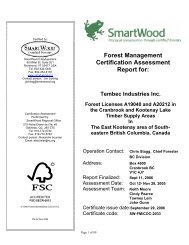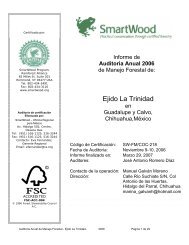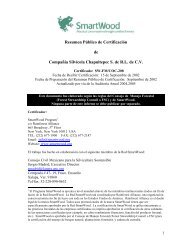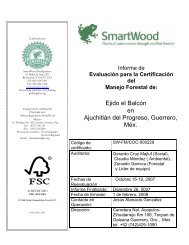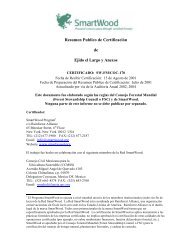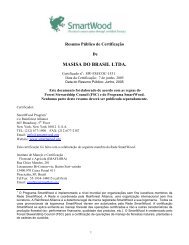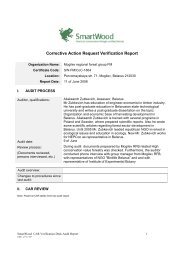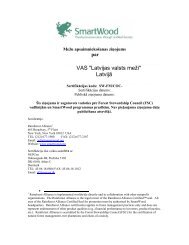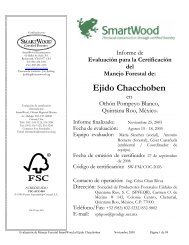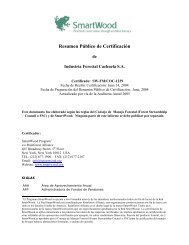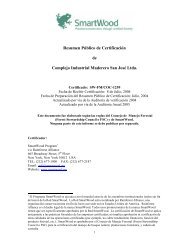[C] The Hidden Frontier of Forest Degradation - Rainforest Alliance
[C] The Hidden Frontier of Forest Degradation - Rainforest Alliance
[C] The Hidden Frontier of Forest Degradation - Rainforest Alliance
Create successful ePaper yourself
Turn your PDF publications into a flip-book with our unique Google optimized e-Paper software.
Garcia River <strong>Forest</strong> Project, California, USA. Cartography: N. Virgilio.<br />
ture. <strong>The</strong>se changes have resulted in both carbon stock<br />
enhancement and emission reductions, and are expected to<br />
result in other ecological benefits such as improved water<br />
quality and a return to a more natural forest composition.<br />
<strong>The</strong> project has been verified in accordance with California<br />
Climate Action Registry (CCAR) <strong>Forest</strong> Project Protocol<br />
version 2.1. Its carbon benefits accrued between 2004 and<br />
2008 have been verified by an accredited third party, for a<br />
total <strong>of</strong> 525,370 tCO 2 e.<br />
DRIVERS AND MAGNITUDE OF DEGRADATION EMISSIONS<br />
Due to rising land prices and strenuous regulation, forest owners<br />
in the Pacific Northwest are increasingly pressured to convert<br />
their properties into other land uses, such as residential subdivisions<br />
and vineyards. In response to these threats, TCF purchased<br />
almost 10,000 ha <strong>of</strong> forest in 2004, using a combination <strong>of</strong><br />
TCF funds and contributions from TNC, <strong>The</strong> California<br />
Coastal Conservancy, the Packard Foundation, and <strong>The</strong> Wildlife<br />
Conservation Board. Previously, the land had been heavily<br />
harvested and was in a highly degraded state upon purchase.<br />
Using the standards for carbon accounting established by<br />
CCAR v2.1, it is estimated that the project will result in over<br />
2,223,373 metric tons <strong>of</strong> carbon stored on the property after<br />
100 years, more than twice the baseline carbon storage, while<br />
providing essential habitat for species such as the northern<br />
spotted owl and anadromous fish.<br />
STRATEGIC APPROACH AND ACCOUNTING METHODS<br />
A random sampling <strong>of</strong> 1,051 permanent inventory plots have<br />
been established and measured within the project area since<br />
2004 (including above and belowground living biomass,<br />
standing dead biomass, and lying dead biomass carbon pools);<br />
new plots are added annually to address recent disturbances<br />
such as harvests and fire. When combined with an additional<br />
540 older plots, the inventory system allows TCF to measure<br />
and monitor carbon stocks associated with the various forest<br />
types over time, with an overall carbon sampling error <strong>of</strong> less<br />
than 5 percent with 90 percent confidence (SGS and SCS,<br />
2007). Through aerial photos taken in 2004, 21 forest stand<br />
types (classified by dominant species, size, and canopy closure)<br />
were identified and outlined within the Garcia River project<br />
area and confirmed with surveys on the ground. Field data was<br />
extrapolated to cover the entire forest based on identified<br />
stand types.<br />
Guidance for determining the project baseline was provided<br />
in the CCAR v2.1 standard, which is based on the<br />
maximum amount <strong>of</strong> timber harvest permitted under the<br />
California State <strong>Forest</strong> Practice Rules. Specifically, under the<br />
baseline management scenario, all forested stands outside <strong>of</strong><br />
required no-cut riparian zones (forest lining rivers and<br />
streams) and those that harbored endangered species would<br />
eventually be harvested. Harvests would follow an even-aged<br />
management plan, where tree stands were clearcut as they<br />
became 60 years or older, followed by single tree selection<br />
harvest every 10 to 20 years as stands re-gained commercial<br />
maturity post-clearcut. This management plan would have<br />
resulted in 1,062,449 metric tons <strong>of</strong> carbon stored on the<br />
property after 100 years.<br />
<strong>The</strong> with-project scenario will result in more carbon stored<br />
on the land than in the baseline scenario by switching to<br />
uneven-aged management with selection harvest. This means<br />
smaller trees, such as tanoak and low-quality redwood/Douglasfir,<br />
will be harvested more frequently to make room for larger<br />
trees to grow more quickly, keeping a variety <strong>of</strong> age classes<br />
across the property. <strong>The</strong> harvest rate will be less than the growth<br />
rate for the first 80 years <strong>of</strong> the project, allowing surplus volume<br />
T H E H I D D E N F R O N T I E R O F F O R E S T D E G R A D A T I O N $ 39


![[C] The Hidden Frontier of Forest Degradation - Rainforest Alliance](https://img.yumpu.com/30611265/43/500x640/c-the-hidden-frontier-of-forest-degradation-rainforest-alliance.jpg)
